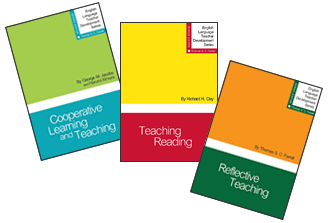Six Games to Motivate Writing Students
by Alison Carnevale
 The following activities facilitate peer and group editing of student writing. They are all collaborative and student-centered, which allows students to engage one another as they problem-solve and discuss their writing. The following activities facilitate peer and group editing of student writing. They are all collaborative and student-centered, which allows students to engage one another as they problem-solve and discuss their writing.
While all the activities are cooperative in nature, some of them also have a competitive aspect. Although competition has not been conclusively proven to increase motivation or learning, the interactive games get students excited, and students look forward to and enjoy the games and activities, which are a nice change of pace in any ESL class (Chanseawrassamee, 2012).
With these activities, there is little preparation time for the teacher because you use the students’ work as the basis for all of the activities, which can be easily adapted to fit the needs of almost any level, class type, or time frame. Depending on class size and other variables, the following activities can take anywhere from 30 minutes to 1 hour.
Essay Revision
1. Opening Paragraphs: Hook Contest
- After reviewing introduction paragraphs (what a hook is, how to write it, and a review of sample hooks), have the students write the introduction paragraph of their essay in class.
- The next day, have them vote on the best hook. Depending on the size of the class, you could put all students’ hooks on a handout (if it’s a bigger class, you could just choose the top three to five hooks).
- Give a copy of the handout to each student and have them anonymously vote for their favorite hook—ask them not to vote for their own.
- Finally, and most important, have them explain why they chose the hook they did. Make a list on the board of qualities and characteristics of an effective and interesting hook.
2. Comparing Two Paragraphs
This activity should be used as part of a longer partner or small-group peer edit workshop, so students will need to have read their partner’s entire essay before completing this activity.
- Depending on what your writing students are having the most difficulty with, choose one part of the essay to focus on. For example, you can give the students a handout with two to three different conclusion paragraphs from student essays. Have students answer specific questions about each paragraph. For example:
- Does the conclusion restate, or paraphrase, the thesis statement?
- Does the conclusion include any new ideas that were not mentioned in the essay? If so, underline them.
- Does the conclusion leave the reader with something to think about? (A question, challenge, suggestion, prediction, etc.)
- Have students read both paragraphs, answer the questions, and then vote on their favorite, explaining why they chose it.
- You can have students do this with a partner or in groups of three. You can also do this activity with body paragraphs, introductions, or summaries.
Grammar Revision: Team Games
3. Peer Edit Team Race
- From students’ essays, write down 5–10 sentences that contain common errors (spelling, grammar, word choice, punctuation, etc.) Make two copies of the sentences and cut them into strips so each sentence is on a separate piece of paper.
- Divide the class into two teams. Give one person from each team one of the sentences needing correction(s). (Try to choose two students who are at about the same level.) The two students have to race to the board to rewrite the sentence correctly. The student who writes the sentence correctly gets a point for his or her team.
- Provide the two students 1 minute to discuss the sentence with their teams before going up to the board (or you can have them revise the sentence individually, with no help from teammates). You can change the rules to suit the needs and personalities of your students.
- Once the two students have their sentences up on the board, have them read their sentences aloud and then elicit from the class which one, if either, is correct. If they are both still wrong, the entire class can help to correct them, and neither team gets the point.
4. Tic-Tac-Toe Revision Game
You can play this game with sentences from student essays that have common errors (spelling, grammar, word choice, punctuation, etc.)
- Make a big tic-tac-toe board on the white/chalk board and in each square, write the incorrect sentence with space underneath for the students to rewrite their revised sentence.
- Choose nine sentences with common errors from student essays and put one sentence in each square. Divide the class into 2 teams and have one person from each team come up to the board at a time, choose one sentence, and rewrite it correctly. If the student gets it wrong, the other team has a chance to “steal” by recorrecting it.
- Provide each student 1 minute to talk with their team about the sentence before they go up to the board. Once at the board, they can’t receive help from their teams. You can change the rules to suit the needs and personalities of your students.
Essay Organization
5. Essay Scramble
- For this activity, students work in teams (with a partner or small group). Each team will receive one copy of the same essay, with each paragraph/topic sentence cut into a separate piece of paper.
- First, make a copy of a well organized student essay (This activity works well for shorter essays between one and two pages).
- You can choose how to divide and cut up the essay, depending on the focus of the lesson. For instance, if the lesson is focused on topic sentences, cut out all the topic sentences. If it is focused on general essay organization (block vs. point by point), you may simply divide the essay by entire paragraphs.
- The teams work together and race to put the essay components in the correct order. The teacher can time the activity or let students work at their own pace.
- To determine the winner you can simply have students raise their hands when they’re done, or you could also have them ring a bell or hold up a sign. You should check that the essay is in the correct order before announcing a winner.
- Once the first team has ordered them correctly, you can have all students stop working, or you could allow all groups to finish.
- After the winner is announced, pass out the essay as a whole and have students discuss how the writer organized the essay and how students knew how to organize the paragraphs (thesis statements, topic sentences, transitions, etc.)
6. Transition/Signal Word Cloze Activity
- Using a student essay, create a cloze activity by deleting specific signal words. You can focus it on different types of transition words, depending on the type of essay you are using.
- Depending on the level, you can provide students with a word box with possible choices.
- Have students work with a partner to complete this activity. This allows them to compare their answers and discuss alternative words and phrases as possible answers.
- The teacher can also assign the students to create their own cloze activity from their essay or their peers’ essays.
Reference
Chanseawrassamee, S. (2012). Teaching adult learners English through a variety of activities: Perception on games and rewards. US-China Foreign Language, 10(7), 1355–1374.
____________________
Alison Carnevale teaches at ELS Language Centers. She received her BA in Spanish and International Relations from The Ohio State University. She later earned her MEd in Literacy/TESOL from the University of Cincinnati. Her research interests are focused in sociolinguistics and the identity and motivation of ELLs. She has taught adult students in IEP, University, and Community ESL settings. She is currently teaching at the ELS Language Center in Penang, Malaysia.
TESOL Blogs Interested in writing a blog for TESOL?
Contact Tomiko Breland with your idea or for details.
Check out the latest TESOL Blogs:
|
Culturally Appropriate Writing, by Elena Shvidko
 I have recently read a study by Paula Maier “Politeness Strategies in Business Letters by Native and Non-Native English Speakers” (1992). In the study, both native and nonnative writers were given a fictional situation in which they missed a job interview in another city. The task was to write a letter to a personnel manager to explain what had happened and persuade the manager to give him or her another chance for an interview. The findings of Maier’s study demonstrated that nonnative writers lacked the use of appropriate politeness strategies and their letters were written in an informal and direct language that could be perceived as rude and even disrespectful. Read More. I have recently read a study by Paula Maier “Politeness Strategies in Business Letters by Native and Non-Native English Speakers” (1992). In the study, both native and nonnative writers were given a fictional situation in which they missed a job interview in another city. The task was to write a letter to a personnel manager to explain what had happened and persuade the manager to give him or her another chance for an interview. The findings of Maier’s study demonstrated that nonnative writers lacked the use of appropriate politeness strategies and their letters were written in an informal and direct language that could be perceived as rude and even disrespectful. Read More.
|
|
Google+ Education: Part 1, by Tara Arntsen
 Perhaps you do not use Gmail as your default e-mail account or Google as your trusty search engine. Still, Google has a number of free tools that could be of great use to teachers, and today I want to talk about one of them, Google Hangouts, which you may find helpful for your teaching, especially when it comes to connecting with students and parents outside the classroom. Perhaps you do not use Gmail as your default e-mail account or Google as your trusty search engine. Still, Google has a number of free tools that could be of great use to teachers, and today I want to talk about one of them, Google Hangouts, which you may find helpful for your teaching, especially when it comes to connecting with students and parents outside the classroom.
A Google Hangout basically allows up to 10 people with Google+ accounts to have a conference online with the option of using a chat box, audio, and video to communicate with one another. Having studied at the University of Southern California and using their online learning platform, I was expecting to be disappointed with the features of Google Hangout, but was pleasantly surprised to find plenty of features available and some free apps to download, too. Read More.
|
|
Great Grammar & Academic Writing Resources for Advanced ELLs, by Alexandra Lowe
 In my last blog post, I offered a quick overview of six grammar websites that I have found consistently helpful to high-beginners and intermediate students looking for additional grammar practice outside of class. This week, we’ll look at several websites that offer grammar and writing assistance for advanced ESL students, including students who are preparing for college-level work in the United States. We’ll also take a look at a new textbook that integrates grammar and academic writing in intriguing new ways. Read More. In my last blog post, I offered a quick overview of six grammar websites that I have found consistently helpful to high-beginners and intermediate students looking for additional grammar practice outside of class. This week, we’ll look at several websites that offer grammar and writing assistance for advanced ESL students, including students who are preparing for college-level work in the United States. We’ll also take a look at a new textbook that integrates grammar and academic writing in intriguing new ways. Read More.
|
TESOL Bookstore

Semesters Are Ending.
It’s Time for Rest and Reflection.
TESOL Has the Ideal Books to Help.
English Language Teacher Development Series
Thomas S. C. Farrell, series editor

Short • Practical • Interactive • 15 Individual Topics
Buy Them All—20% OFF purchase of 3 or more
Dr. Farrell is renowned for his work around the world in reflective practice and language teacher education and development. His vision for the ELTD Series was to present a theory-to-practice approach in a set of short resource books written in a jargon-free and accessible manner for all types of teachers of English (native and nonnative speakers of English, experienced and novice teachers). Each affordable book offers a variety of practical methods and time for reflections that allow teachers to interact with the materials presented.
Toll Free: 888-981-0041
E-mail: tesol@brightkey.net
|
 |
|
|
 |
| U.S. Embassy ESL/EFL Projects, U.S. Department of State English Language Fellow Program, Worldwide
Disney English Foreign Trainer, Disney English, Multiple cities in China
Full-Time Lecturer, Department of Linguistics (TESOL area), Southern Illinois University Carbondale, Illinois, USA
Lecturer (non-tenure-track), Southern Illinois University, Rural
U.S. Embassy Projects - Senior Fellow, U.S. Department of State English Language Fellow Program, Worldwide
Want to post your open positions to Job Link? Click here.
To browse all of TESOL's job postings, check out the TESOL Career Center. |
 |
|
 |
| ADVERTISEMENT |

|
 |
|